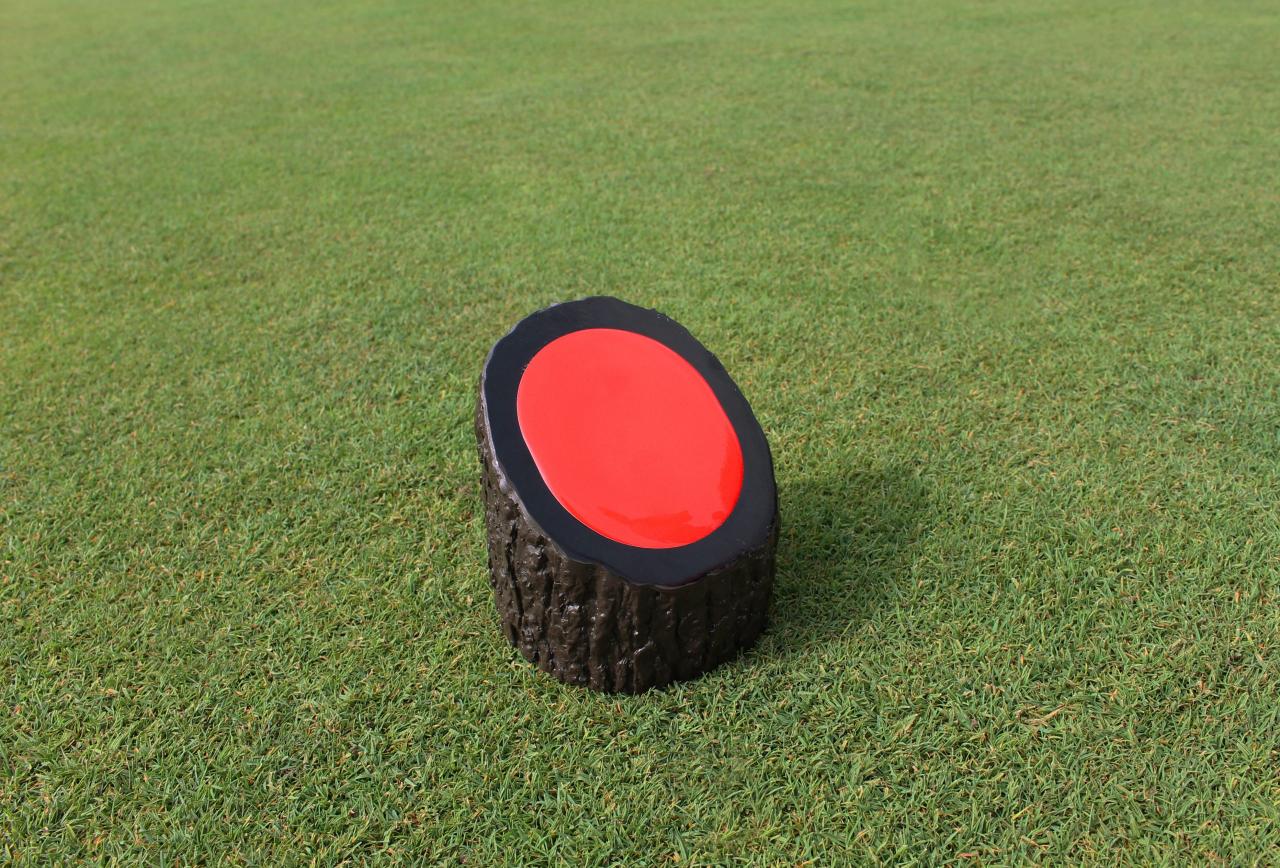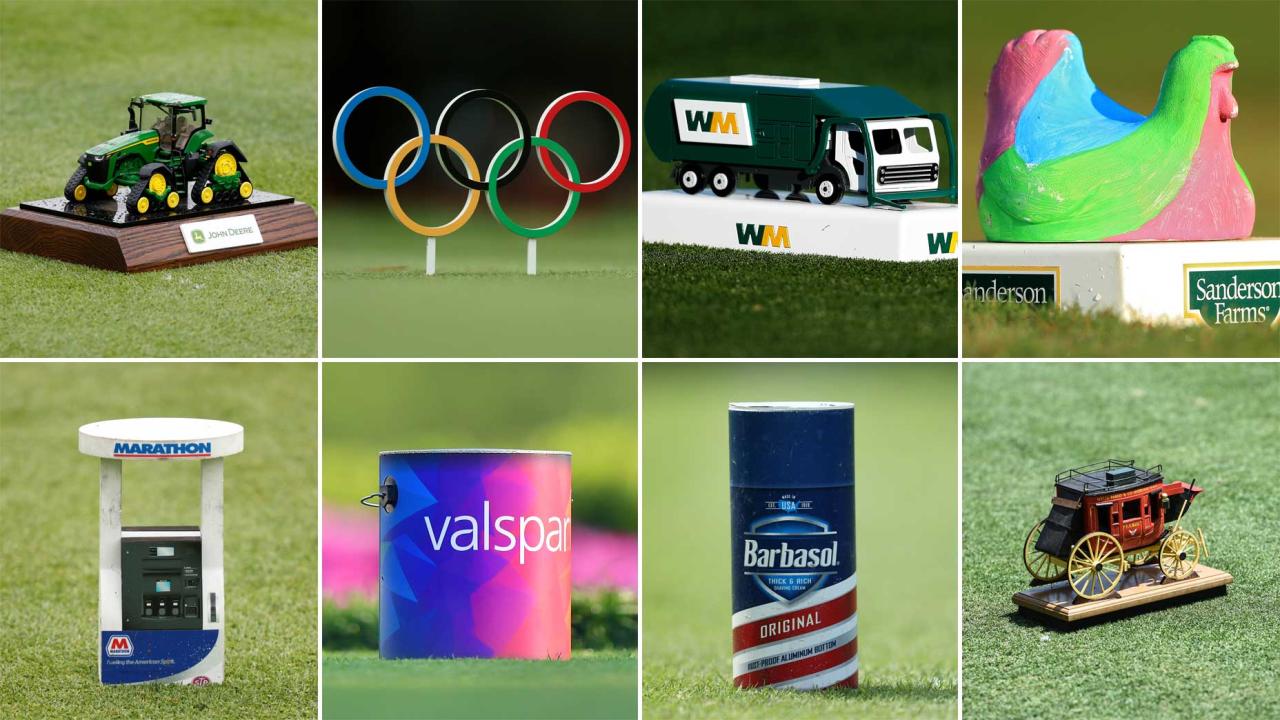Golf tee markers, those unassuming little objects found scattered across the course, play a crucial role in the game. From their humble beginnings to their modern-day iterations, these markers have evolved alongside the sport itself, reflecting the changing needs and preferences of golfers.
This exploration delves into the fascinating world of golf tee markers, uncovering their history, materials, types, and the vital role they play in shaping the golfing experience.
The humble golf tee marker is more than just a simple object; it represents a confluence of history, innovation, and practicality. From the earliest days of the game, when players used natural objects to mark their teeing grounds, to the present-day array of sophisticated materials and designs, golf tee markers have consistently served as a silent partner in the pursuit of the perfect shot.
Golf Tee Markers
Golf tee markers, often referred to simply as “tee markers,” are small, often brightly colored objects placed on the ground to indicate the starting point for a golf hole. They are essential for ensuring fair play and a consistent starting position for all golfers.
Types of Golf Tee Markers
Tee markers come in a variety of materials and designs, each with its own advantages and disadvantages. Here are some of the most common types:
- Plastic Tee Markers: These are the most common type of tee marker, as they are inexpensive, durable, and available in a wide range of colors. Plastic tee markers are often used on public courses and are generally considered to be a good value for the price.
- Metal Tee Markers: Metal tee markers are typically made from aluminum or stainless steel. They are more durable than plastic tee markers and can withstand more wear and tear. However, they are also more expensive. Metal tee markers are often used on private courses or courses with a high volume of play.
- Wooden Tee Markers: Wooden tee markers are a more traditional option. They are often made from hardwoods like oak or maple and are typically more expensive than plastic or metal tee markers. Wooden tee markers are often used on courses that have a more rustic or traditional aesthetic.
History of Golf Tee Markers
The use of tee markers in golf can be traced back to the early days of the game. In the early 19th century, golfers would often use a small piece of wood or stone to mark the starting point for a hole.
However, these early markers were often inconsistent in size and shape, leading to unfair starting positions.The development of standardized tee markers began in the late 19th century. The first tee markers were made of metal and were often shaped like a pyramid or a cone.
These early tee markers were designed to be durable and to provide a consistent starting point for all golfers.In the early 20th century, plastic tee markers became popular. Plastic tee markers were cheaper to produce than metal tee markers and were also more durable.
They quickly became the most popular type of tee marker and have remained so ever since.Today, golf tee markers are an essential part of the game. They help to ensure fair play and a consistent starting position for all golfers.
Placement and Use

Golf tee markers are essential tools for navigating the course and ensuring fair play. They are strategically placed to provide golfers with clear visual cues and guidance, promoting a more enjoyable and efficient golfing experience.
Proper Placement, Golf tee markers
Tee markers are typically placed at the beginning of each hole, indicating the starting point for the round. They are usually positioned on the tee box, a designated area of the fairway, and are designed to be easily visible from a distance.
The placement of tee markers is crucial for several reasons:
- Defining the Starting Point:Tee markers clearly indicate the precise location where players should begin their round, ensuring consistency and fairness for all golfers. This eliminates any ambiguity regarding the starting position and promotes a level playing field.
- Guiding the Players:They serve as visual landmarks that guide golfers towards the fairway, helping them maintain a proper starting direction and preventing them from straying off course.
- Ensuring Safety:Tee markers help prevent golfers from accidentally hitting other players or spectators who may be positioned near the tee box. They create a safe and organized environment for all involved.
Effective Use
Golfers should familiarize themselves with the proper use of tee markers to enhance their golfing experience. Here are some tips and techniques:
- Understanding the Tee Markers:Different courses may use various types of tee markers, such as flags, posts, or even painted lines. It is important to understand the specific markers used on a particular course and how they are used to indicate the starting point.
- Placement of the Ball:The tee marker is not the exact spot to place the ball; it is a reference point. The ball should be placed within a designated area, typically a few inches behind the tee marker. This ensures a fair starting position for all players.
- Tee Height:The tee marker is also a visual aid for determining the appropriate tee height. The height of the tee should be adjusted based on the tee marker’s position and the desired launch angle.
- Respecting the Markers:Tee markers are crucial for fair play and course etiquette. Golfers should avoid disturbing or moving the markers unless directed by course officials.
Enhancing the Golfing Experience
Tee markers play a vital role in enhancing the golfing experience by promoting fair play, efficiency, and a sense of order on the course.
- Fair Play:Tee markers establish a consistent starting point for all players, ensuring a level playing field and promoting fairness.
- Efficiency:They streamline the game by providing clear visual cues and reducing confusion regarding the starting point. This allows golfers to focus on their game and move through the course efficiently.
- Sense of Order:Tee markers contribute to a sense of order and structure on the course, enhancing the overall golfing experience.
Environmental Considerations

The environmental impact of golf tee markers is a crucial aspect to consider, especially given the growing awareness of sustainability in the golfing industry. Choosing environmentally friendly materials and implementing responsible practices can significantly minimize the footprint of these seemingly small items.
Materials and Their Environmental Impact
The materials used for golf tee markers have varying environmental impacts.
- Plastic:While widely used due to its affordability and durability, plastic tee markers pose a significant environmental threat. They are not biodegradable and can persist in the environment for hundreds of years, contributing to plastic pollution.
- Wood:Wood tee markers are a more sustainable option than plastic, as they are biodegradable. However, sourcing wood from responsibly managed forests is essential to avoid contributing to deforestation.
- Metal:Metal tee markers, such as those made from aluminum or steel, are durable and can be recycled. However, their production requires significant energy and resources.
Biodegradable and Sustainable Tee Markers
The golf industry is increasingly embracing biodegradable and sustainable tee markers.
- Bioplastics:Bioplastics, derived from renewable resources like corn starch or sugarcane, are biodegradable and offer a more environmentally friendly alternative to traditional plastic.
- Bamboo:Bamboo is a rapidly renewable resource that can be used to create biodegradable and durable tee markers. Its fast growth rate makes it a sustainable choice for manufacturing.
- Recycled Materials:Utilizing recycled materials, such as recycled plastic or paper, for tee marker production reduces waste and promotes circularity.
Initiatives and Best Practices
Several initiatives and best practices can help minimize the environmental footprint of golf tee markers:
- Promoting Biodegradable Options:Golf courses can encourage the use of biodegradable tee markers by providing them to golfers or making them readily available for purchase.
- Recycling Programs:Implementing tee marker recycling programs on golf courses allows for the collection and proper disposal of recyclable materials.
- Educational Campaigns:Raising awareness among golfers about the environmental impact of tee markers through educational campaigns can encourage responsible choices.
Golf Tee Markers in the Future
The world of golf tee markers is poised for exciting advancements, driven by technological innovation and evolving player preferences. From enhanced materials to smart features, the future holds the promise of tee markers that are more durable, versatile, and even personalized.
Emerging Technologies and Materials
The evolution of golf tee markers is intertwined with the advancement of materials science. Manufacturers are constantly exploring new materials that offer superior performance and sustainability.
- Bio-based materials: A growing trend in the golf industry is the use of bio-based materials derived from renewable sources, such as bamboo and corn starch. These materials offer a sustainable alternative to traditional plastics, reducing the environmental impact of tee marker production.
- High-performance polymers: Innovations in polymer technology are leading to the development of tee markers that are exceptionally durable and resistant to wear and tear. These materials can withstand harsh weather conditions and repeated use, ensuring that tee markers maintain their shape and integrity throughout their lifespan.
- Smart materials: The integration of smart materials into tee markers is opening up a world of possibilities. For example, materials that change color based on temperature or UV exposure could provide players with valuable information about the playing conditions.
Personalized Tee Markers
In the future, golf tee markers may become more personalized, reflecting the unique preferences and style of individual golfers.
- Customizable designs: Players may be able to design their own tee markers, incorporating logos, initials, or even favorite golf course imagery. This allows golfers to express their individuality on the course.
- Interactive features: Imagine tee markers that connect to smartphone apps, providing real-time data on shot distance, club selection, and even course conditions. This type of interactive technology can enhance the golfing experience and improve player performance.
The Role of Tee Markers in Shaping the Future of Golf
Beyond their practical function, golf tee markers have the potential to play a significant role in shaping the future of the game.
- Enhancing accessibility: Innovative tee markers can help make golf more accessible to players of all abilities. For example, tee markers that adjust to different heights could accommodate players of varying stature.
- Promoting sustainability: The use of eco-friendly materials and sustainable manufacturing practices will contribute to a greener golf industry. This aligns with the growing awareness of environmental responsibility among golfers.
- Enriching the golfing experience: Tee markers can become more than just functional objects. They can be used to enhance the visual appeal of the course, provide players with valuable information, and even serve as a platform for social interaction.
Expert Answers: Golf Tee Markers
What is the best material for a golf tee marker?
The best material depends on your priorities. Plastic is affordable and durable, while metal is more robust and can withstand harsh weather conditions. Biodegradable options are becoming increasingly popular for their environmental benefits.
Are there any regulations regarding the use of golf tee markers?
Most golf courses have specific rules about the placement and type of tee markers allowed. Check with the course you’re playing on for their specific guidelines.
How do I choose the right type of golf tee marker?
Consider your personal preferences, the course conditions, and the type of shots you typically play. Alignment markers can be helpful for aligning your swing, while biodegradable options are environmentally friendly.

